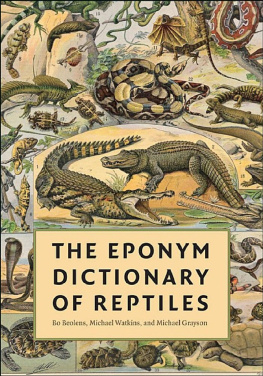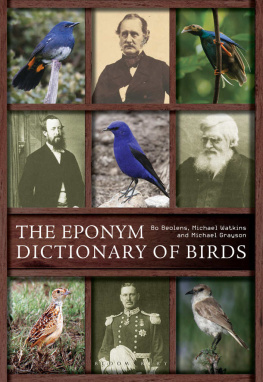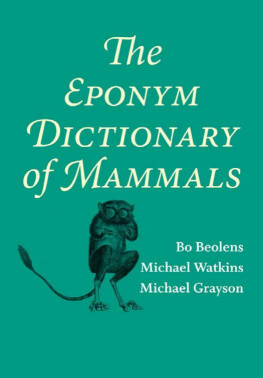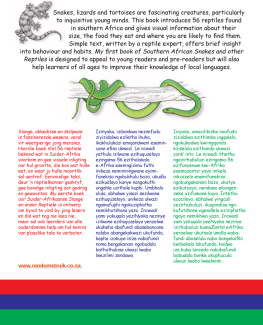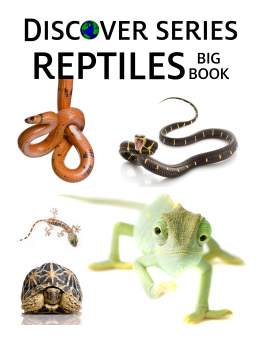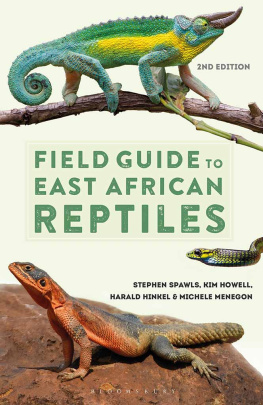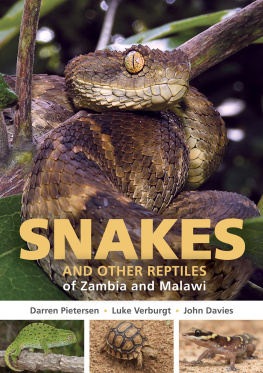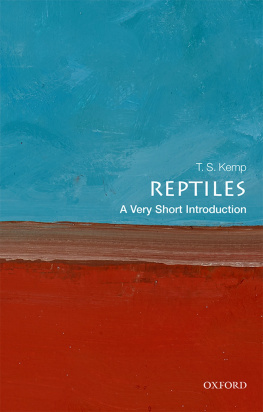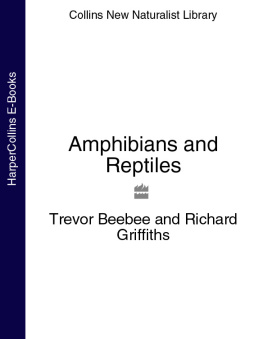The Eponym Dictionary of Reptiles
The Eponym Dictionary of Reptiles
Bo Beolens
Michael Watkins
Michael Grayson

2011 The Johns Hopkins University Press
All rights reserved. Published 2011
Printed in the United States of America on acid-free paper
9 8 7 6 5 4 3 2 1
The Johns Hopkins University Press
2715 North Charles Street
Baltimore, Maryland 21218-4363
www.press.jhu.edu
Library of Congress Cataloging-in-Publication Data
Beolens, Bo.
The eponym dictionary of reptiles / Bo Beolens, Michael Watkins, and Michael Grayson.
p. cm.
Includes bibliographical references.
ISBN-13: 978-1-4214-0135-5 (hardcover : alk. paper)
ISBN-10: 1-4214-0135-5 (hardcover : alk. paper)
1. ReptilesDictionaries. 2. EponymsDictionaries.
I. Watkins, Michael, 1940 II. Grayson, Michael. III. Title.
QL640.7.B46 2011
597.903dc22 2010050260
A catalog record for this book is available from the British Library.
Special discounts are available for bulk purchases of this book. For more information, please contact Special Sales at 410-516-6936 or specialsales@press.jhu.edu.
The Johns Hopkins University Press uses environmentally friendly book materials, including recycled text paper that is composed of at least 30 percent post-consumer waste, whenever possible.
To my late parents, Eric and Phyllis Crombet-Beolens,
lost to me during the writing of this eponym dictionary,
who encouraged and fostered my lifelong interest in wildlife
Bo Beolens
CONTENTS
PREFACE
Two of us, Bo Beolens and Mike Watkins, wrote Whose Bird?, published in 2003. A review of it was written by Nicholas Gould for International Zoo News. Gould suggested that there could be a need for similar volumes on other animal orders, and among them he suggested Whose Mammal? and Whose Reptile? We wish to give credit to him whose suggestion led us to write this book as well as The Eponym Dictionary of Mammals, published by the Johns Hopkins University Press in 2009.
We are deeply indebted to the following people and organizations for their generous help with research and, where needed, translations: Kraig Adler, Professor of Biology, Cornell University, USA; Sebastian Aigner, sterr. Akademie der Wissenschaften, Vienna, Austria; Eva M. Albert, Estacin Biolgica de Doana (CSIC), Spain; Sylvie Coten-Watkins, Montmorency, France; Patrick Couper, Curator of Herpetology, Queensland Museum, Brisbane, Australia; Paola Gonzalez Abarca, Librarian, Museo Nacional de Historia Natural, Santiago de Chile; Jakob Hallerman, Zoologischen Museum der Universitt Hamburg; Notker Helfenberger, St. Gallen, Switzerland; Robert William Henderson, Senior Curator, Herpetology, Milwaukee Public Museum, USA; Stefan Koerber, Ichthyologist, Muelheim, Germany; Anton Maslov, St. Petersburg, Russia; Petr Neas, Herpetologist, Czech Republic; Giuseppe Osella, Professor of Zoology and Entomology, LAquila University, Italy; Geoffrey Patterson, Wellington, New Zealand; Christopher Raxworthy, American Museum of Natural History, New York, USA; Edoardo Razetti, Museum of Natural History, University of Pavia, Italy; John Rose, Assistant Librarian, British Museum of Natural History, London; Jevgeni Shergalin, Carmarthen, Wales; Peter Uetz, University of Delaware, Newark, Delaware, USA; Fernando Videla, Professor, Instituto Argentino de Investigaciones de Zonas Aridas; Manfred Warth, Staatlisches Museum fr Naturkunde, Stuttgart, Germany; Charles Watkins, Montmorency, France; Nicholas and Katherine Watkins, Oxford, England; Suzanne Watkins, Bushey Heath, Herts, England; Madame Zouaq, Librarian, Musum National dHistoire Naturelle, Paris; Dr. Marco Zuffi, Editor-in-Chief, Acta Herpetologica Italiana, Italy.
Our thanks are also due to those people mentioned in the book who amended their entries.
INTRODUCTION
Who Is It For?
Vernacular names of animals often contain a persons name (such names are called eponyms). We have all heard of Russells Viper, but how familiar is Uzzells Lizard? So this book is for both the amateur herpetologist and the student of zoology.
How to Use This Book
This book is arranged alphabetically by the names of the people after whom reptiles have been named. Generally, the easiest way to find your animal is to look it up under the personal name that is apparently embedded in the animals common or scientific name. We say apparently because things are rarely as simple as they seem. In some names, for example, the apostrophe implying ownership is a transcription error; other names may refer to places rather than to people. We have included any names where we think confusion might arise, but we do not promise to have been completely comprehensive in that respect. You should also beware of spelling. Surf the Net, and you may well find animals names spelled in a number of different waysthat greatest resource is also full of inaccuracies and misinformation. We have tried to include entries on those alternatives that we have come across.
Each biography follows a standard format: First, you will find the name of the person honored. Next, there follows a list of animals named after that person, arranged in order of the year in which they were described. (This list gives common names, scientific names, names of the people who first described each species, and the date of the original descriptionsin that sequence). Alternative English names follow in square brackets and are each preceded by the abbreviation Alt. Different scientific names (where taxonomists disagree) are preceded by the abbreviation Syn. (synonym). Finally, there is a brief biography of that individual. Space constraints limited us to mentioning only one publication written by each person.
To assist you in your search, we have cross-referenced the entries by highlighting (in bold) the names of those describers who also appear elsewhere in the book. Some reptiles are named in different ways after the same person, and we have also tried to marry these up using cross-references.
A persons fame does not correspond to the length of the entryin fact, often the opposite. A very famous person would have a fairly brief write-up, as he or she would be so well known, and so written-about, that it is necessary for us just to indicate that he or she is the person commemorated.
Sometimes reptiles are named in the vernacular after the finder, the person who wrote the description, or some other person of the latters choice. When more than one person has thought a species new, the reptiles may get more than one set of names, so it can warrant an entry in several places.
There are a great number of recent namings of fossil animals. As the rate at which fossil remains are discovered and described seems to be increasing exponentially and the disagreement among the paleontologists epidemic, we decided that we would ignore any prehistoric extinctionsin simplistic terms, those occurring before Columbus discovered America.
In the last 100 years many cities and countries have changed names. We have normally used the name by which the subject would have known it, putting in parentheses the name by which it is now knownfor example, Salisbury (Harare), Rhodesia (Zimbabwe).
Whats in a Name?
Tracking down the provenance of eponymous reptile names, and finding out about the individuals responsible for them, proved to be fraught with difficulties. The final count is 4,130 animals plus 43 genera and including a few where the same animal has been named after two people. The names honor 2,330 individual people, but there are also 99 that sound like peoples names but in fact are not, plus 15 indigenous peoples, 5 fictional characters, 2 biblical references, and 34 references to mythology. Additionally, there are entries for 15 names of people whom we have been unable to identify.
Next page
